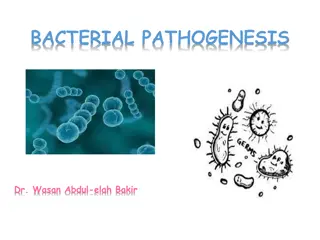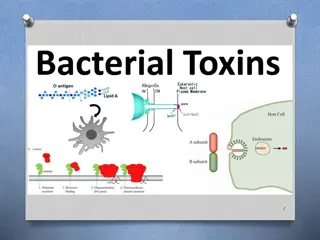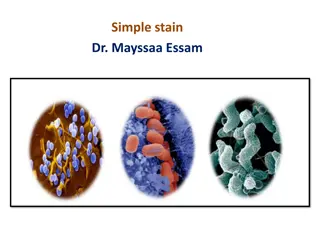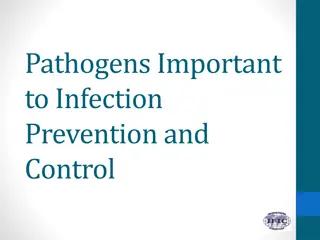Surgical Prophylaxis and Antimicrobial Selection Guidelines in Surgery
Surgical prophylaxis involves administering antibiotics before contamination of previously sterile tissues to prevent infections. Common pathogens in surgical site infections include skin flora like S. aureus. Antimicrobial selection is based on the surgical procedure, likely pathogens, and safety c
4 views • 19 slides
Understanding Bacterial Pathogenesis: Key Concepts and Factors
Bacterial pathogenesis involves the ability of certain bacteria to cause disease by attributes such as transmissibility, adherence, motility, invasion, and toxigenicity. Pathogens can exploit host defenses, while virulence determines the severity of infection. Learn about opportunistic pathogens, no
7 views • 36 slides
Understanding Bacterial Toxins and Cell Damage
Bacterial toxins are poisonous substances produced by microbes that can cause harm to host cells through direct damage, toxin production, and hypersensitivity reactions. Toxigenesis is a crucial mechanism used by bacterial pathogens to induce disease, with endotoxins and exotoxins playing distinct r
2 views • 28 slides
Understanding Pneumonia: Causes, Classification, and Risk Factors
Pneumonia is an infection of the lower respiratory tract that can be classified anatomically and etiologically. The common causes include bacterial, viral, and fungal pathogens, as well as aspiration pneumonia. Factors such as immune deficiency, overcrowding, and poor hygiene can increase the risk o
10 views • 37 slides
Anaerobic Bacterial Infections: Overview and Clinical Implications
Anaerobic bacterial infections are caused by bacteria that do not require oxygen for growth, posing challenges in diagnosis and treatment. This article delves into the types of anaerobic bacteria, their role in human infections, and common clinical presentations such as abscess formation. Gram-negat
2 views • 24 slides
Understanding Food Microbiology: Sources of Contamination
Humans have broader nutritional requirements than most microorganisms. The human diet includes a wide variety of substances, making our food excellent media for microbial growth. Natural contamination of food by various microorganisms, including pathogens, is common. Food consumed by humans and anim
0 views • 51 slides
Understanding Bacterial Physiology and Growth
Bacterial physiology encompasses the growth, nutrition, and metabolism of bacteria. Bacterial growth involves binary fission, generation time, colony formation, and is influenced by various factors such as temperature, atmosphere, moisture, and radiation. Understanding the classification based on te
0 views • 33 slides
Exploring Bacterial Flagella: Structure and Function
Bacterial flagella are long, thin appendages crucial for motility in bacteria. Composed of filament, basal body, and hook, these structures play a vital role in bacterial movement. This article dives into the detailed structure and functionality of bacterial flagella, highlighting their importance i
0 views • 9 slides
Understanding Bacterial Locomotion: Flagellar Structure and Movement Mechanism
Bacterial locomotion involves intricate flagellar structures composed of filaments, basal bodies, and hooks. The synthesis of flagella is a complex process controlled by numerous genes. The rotation of the flagellar helix acts as a motor, determining the direction of bacterial movement.
1 views • 12 slides
Understanding Bacterial Photosynthesis: Types and Processes
Photosynthesis is the conversion of light energy into chemical energy, crucial for growth and production of ATP. Prokaryotes such as cyanobacteria, purple and green bacteria, and halobacteria demonstrate different forms of photosynthesis. Oxygenic photosynthesis, found in cyanobacteria, releases oxy
2 views • 20 slides
Introduction to Phage DNA Integration in Bacterial Cells
Phage DNA can be introduced into bacterial cells through two methods: transfection and in vitro packaging. Transfection involves mixing purified phage DNA with competent E. coli cells, inducing DNA uptake via heat shock. In vitro packaging utilizes proteins coded by the phage genome, which can be pr
1 views • 13 slides
Bacterial Culture Transfer Techniques and Growth Indicators
Bacterial cultures can be transferred using aseptic techniques to ensure purity. Growth indicators such as turbidity in liquid media and colonies on agar plates signify microbial growth. Proper sterilization and handling of instruments are crucial in the process. Techniques like streaking on agar pl
1 views • 4 slides
Bloodborne Pathogens Training Overview for Ground Team Members
Understanding bloodborne pathogens is crucial for ground team members to protect themselves and others. This training covers what bloodborne pathogens are, focusing on Hepatitis B Virus (HBV) and Human Immunodeficiency Virus (HIV), their symptoms, transmission risks, and prevention methods. HBV fact
0 views • 29 slides
Biocontrol Activity of Actinomycetes Against Pathogens of Tomato and Carrot
Plants face various stresses due to climate change, making them vulnerable to pathogens. Actinomycetes, such as Streptomyces, are beneficial soil bacteria with antimicrobial properties that can promote plant growth and suppress diseases. Research explores their antagonistic activity against fungal a
0 views • 13 slides
Vector Relationships and Pathogen Transmission
Understanding mechanical and biological vectors, reservoir hosts, and their role in disease transmission is crucial for effective disease control. Mechanical vectors like flies can transfer pathogens without getting infected, while biological vectors like mosquitoes carry pathogens that reproduce in
1 views • 5 slides
Revolutionary N-Assay: Transforming Pathogen Detection in Healthcare
Innovative N-Assay developed by Jonathan Faro, MD, PhD, offers a faster, more accurate, and cost-effective solution for detecting bacterial pathogens in healthcare settings. Unlike traditional assays, N-Assay differentiates between viable and non-viable pathogens, provides information on antibiotic
1 views • 15 slides
Understanding Water-borne Diseases and Pathogens
Drinking contaminated water can lead to water-borne diseases, causing millions of deaths annually, especially in developing countries. Potable water is essential for health and development, as water-related diseases arise from inadequate water quality and poor sanitation practices. Various pathogens
1 views • 28 slides
Bloodborne Pathogens Training for Public Safety Officers & Sergeants
Bloodborne pathogens (BBPs) are pathogenic microorganisms found in human blood that can cause diseases like HIV, Hepatitis B, and Hepatitis C. Public safety officers and sergeants face occupational exposure to BBPs and should follow OSHA's BBP Standard to protect themselves. Training, vaccinations,
0 views • 41 slides
Understanding the Genus Neisseria: Pathogens and Characteristics
The genus Neisseria comprises important pathogens such as Neisseria meningitidis and Neisseria gonorrhoeae, causing meningitis, gonorrhea, and other infections. This article explores their characteristics, differentiation from non-pathogenic species, properties like Gram-negative diplococci, and ser
0 views • 32 slides
Understanding Bacterial Spore Survival and Thermal Death Rates
Survival of bacterial spores during heat processing is crucial for food safety. The concept of Decimal Reduction Time (D value) and Thermal Death Time (TDT) curve help in understanding the thermal destruction of bacteria or spores. The Z value indicates the change in temperature necessary to cause a
6 views • 14 slides
Understanding OSHA Bloodborne Pathogens Training and Hepatitis B Virus
Covering the basics of OSHA Bloodborne Pathogens Standard, this training material provides essential information on bloodborne pathogens, including Hepatitis B Virus (HBV). It emphasizes the importance of training for individuals with occupational exposure, outlining crucial topics such as Hepatitis
2 views • 56 slides
Understanding Host-Parasite Relationship in Microbiology
In microbiology, the host-parasite relationship is crucial for understanding diseases caused by pathogens. This lecture covers definitions of terms like pathogenicity, pathogen, disease, resistance, susceptibility, infection, virulence, and transmissibility. It also delves into the division of host
0 views • 16 slides
Understanding and Controlling Plant Pathogens for Sustainable Agriculture
Plants are essential for our survival, providing food, materials, and clean air. However, they are susceptible to diseases caused by pathogens like bacteria, viruses, fungi, and protists. These diseases can lead to reduced crop yields and increased costs. To control plant pathogens and pests, method
5 views • 28 slides
Understanding Bacterial Endospores and Sporulation Process
Bacterial endospores are dormant structures that allow bacteria to survive harsh conditions. They contain vital genetic material and are resistant to drought, heat, radiation, and chemicals. The process of sporulation involves the formation of endospores within bacterial cells, followed by germinati
0 views • 34 slides
Understanding Bacterial Taxonomy and Staining Techniques
Bacterial taxonomy involves classifying and identifying bacteria, while staining techniques such as Gram staining help differentiate between Gram-positive and Gram-negative bacteria. This article discusses the importance of distinguishing bacterial strains, preparing smears, and performing different
0 views • 17 slides
Understanding Bacterial Growth and Reproduction in Microbiology
Bacterial growth involves binary fission where cells divide into two, leading to the formation of new cells. The generation time varies among species. The growth curve consists of lag, exponential, stationary, and death phases, each with distinct characteristics. By understanding these phases, resea
0 views • 15 slides
Understanding Bacterial Flagella: Structure and Function
Bacterial flagella, known as flagellum, are hairlike appendages responsible for swimming motility. They are composed of three parts - the filament, basal body, and hook. The filament is a hollow cylinder made of flagellin protein subunits. The synthesis of flagella involves multiple genes. This arti
0 views • 6 slides
Understanding Bacterial Colony Morphology for Microbiology Analysis
Bacterial colonial morphology plays a crucial role in identifying bacteria and fungi. This exercise focuses on recognizing the cultural characteristics of bacteria on agar plates through colony morphology. Each colony represents a genetically similar group of microorganisms derived from a single cel
1 views • 6 slides
Mechanisms and Role of Horizontally Transferred Genetic Elements in Bacterial Disease Pathogenesis
This presentation explores the transfer of foreign DNA into bacteria, discussing mechanisms such as conjugation, transduction, and transformation. It delves into the significance of Mobile Genetic Elements (MGEs) like plasmids, bacteriophages, and transposons in bacterial virulence and pathogenesis.
0 views • 20 slides
Understanding Bacterial Morphology and Simple Stain Techniques
Explore the characteristics of bacteria based on their shape and structure, grouped into spherical, rod-shaped, and helical types. Learn about bacterial smear preparation principles and the simple stain procedure for observing bacterial cells under a microscope. Discover various bacterial species an
0 views • 13 slides
Evaluation of Petroleum Hydrocarbon Degraders in Wastewater Canal Supplemented with Organic Carbon Source
This study explores the potential of native bacterial populations in wastewater for bioremediation of petroleum hydrocarbon-polluted environments. The research involved exposing Bonny light crude oil to wastewater canal samples supplemented with dry maize cob as an organic carbon source. Results sho
0 views • 26 slides
Bloodborne Pathogens Training Overview
This presentation provides essential information on Bloodborne Pathogens Training, emphasizing the importance of understanding and managing exposure to potentially infectious materials. It covers topics such as the Bloodborne Pathogens Standard, Exposure Control Plan, hazards associated with BBPs, a
0 views • 20 slides
Understanding the Immune System: Defenses Against Pathogens
Delve into the intricate workings of the immune system as it fights off pathogens to protect the body. Explore how external defenses like tears, saliva, and skin, along with internal defenses like inflammation and white blood cells, work together to maintain homeostasis and safeguard against sicknes
0 views • 21 slides
Molecular Investigation of Zoonotic Pathogens in Rodents of Iran
This presentation explores the molecular investigation of zoonotic pathogens such as Coxiella burnetii, Bartonella, Rickettsia, Ehrlichia, Brucella, and Borrelia in rodents of Iran. It discusses the background of zoonotic disease pathogens, disease reservoirs, characteristics of Coxiella burnetii, v
0 views • 58 slides
Understanding Pathogens and Immune Response Mechanisms
Pathogens, such as bacteria, viruses, and fungi, can cause infectious diseases in humans, animals, and plants. The immune system defends against these pathogens through various mechanisms, including the production of antibodies, phagocytosis, and the activation of specific defense cells like white b
0 views • 4 slides
Understanding Infectious Diseases and Prevention Strategies
Infectious diseases are caused by pathogens like bacteria, viruses, parasites, or fungi invading the body. These diseases can spread from person to person and sometimes from animals to humans. Common characteristics include potential severe outcomes, transmission modes, and the role of pathogens. Th
0 views • 27 slides
Understanding Gram Staining in Bacterial Identification
Gram staining is a crucial technique in identifying bacterial organisms, developed by Hans Christian Gram. It involves differentiating bacteria into gram-positive and gram-negative groups based on cell wall properties. Gram staining has five basic steps and helps in determining bacterial characteris
0 views • 15 slides
Bacterial Conjugation: Mechanism and Applications
Bacterial conjugation is the process of transferring genetic material between bacterial cells through direct contact or bridge-like connections. Discovered in 1946, this mechanism enables the transfer of DNA regions between various bacterial species, including Gram-negative and Gram-positive bacteri
0 views • 58 slides
Bacterial Cell Shapes and Simple Stain Procedure
Explore the three basic shapes of bacterial cells - Coccus, Bacillus, and Spiral - and learn about different arrangements within each shape. Dive into the Simple Stain procedure, a straightforward staining technique using single stains like methylene blue and crystal violet, to prepare and visualize
0 views • 32 slides
Understanding Special Pathogens for Infection Prevention and Control
Pathogens such as Mycobacterium tuberculosis, Clostridium difficile, and antibiotic-resistant organisms like MRSA and VRE pose significant challenges to infection prevention programs. This content discusses the impact of these pathogens, transmission of tuberculosis, and clinical forms of TB. Antibi
0 views • 51 slides







































